When we speak of Hibiscus plants, the first thing that strikes our mind is the big vibrant flowers. They flower in the spring and summer. But what if your Hibiscus is not blooming?
Not enough sunlight, bad watering habits, improper fertilization, and pest infestation are the primary reasons why your Hibiscus is not blooming. To make your hibiscus bloom, provide them with proper sunlight, water, and fertilizer. Also, remember to overwinter the plant during the winters.
Keep reading this article to understand the reasons behind Hibiscus not blooming in detail and how to encourage them to bloom again.
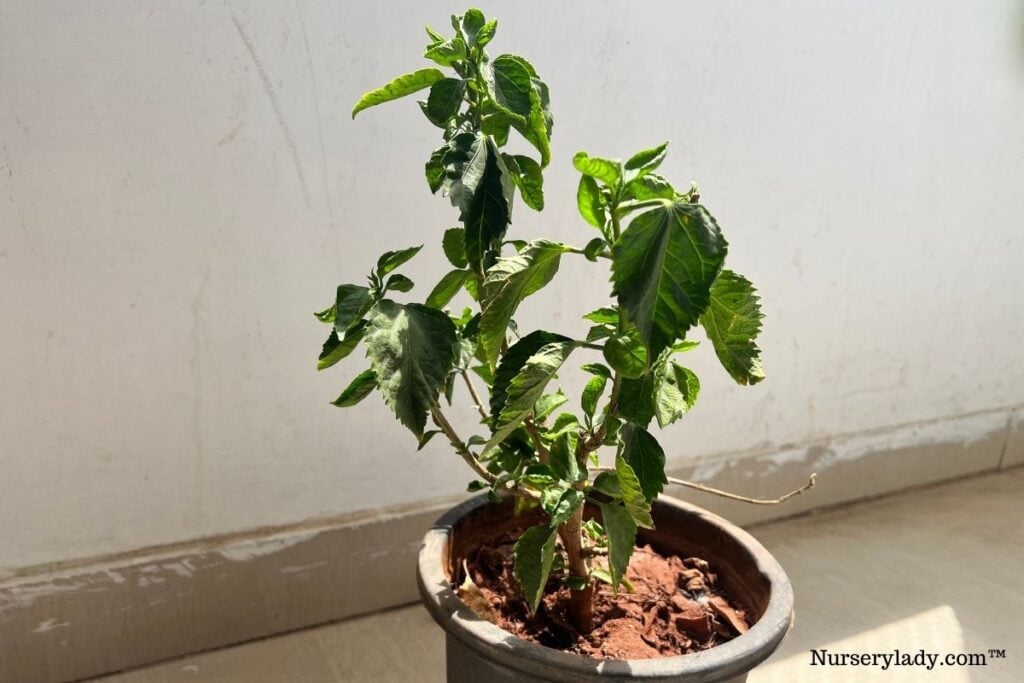
Why is my Hibiscus not blooming?
Your Hibiscus will not bloom if it doesn’t get the ideal conditions or the right care.
Let’s look at all the factors that do not let your hibiscus bloom.
Poor sunlight
Sunlight is essential for Hibiscus.
They need 6 to 8 hours of sun for good growth and development.
Under the full sun, Hibiscus grows and flowers at its full potential.
Shade is the opposite of the plant’s requirement.
It stops the plant from using its entire energy to bloom.
Due to this, the plant won’t have any blooms even in the growing months.
Since they like warm temperatures and sunny climates, it is essential to let them have sufficient sunlight.
Bad watering habits
Hibiscus enjoys consistently moist soil.
Hardy Hibiscus can tolerate wet soil to some extent, but not for prolonged periods.
On the other hand, Hibiscus will also not tolerate prolonged droughts.
Although Tropical Hibiscus can tolerate drought a little more than perennials, that’s not for a very long time.
Overwatering will weaken the plant and make it drop the flower buds.
Dehydration is another reason behind no flowering.
This can happen when the plant is exposed to direct sunlight the whole day.
Poor drainage
Indeed Hibiscus enjoys slightly moist soil, but they won’t enjoy standing over a pool of water.
If the problem happens despite proper watering, it is due to slow-draining soil.
If the soil doesn’t drain enough water, it will stay around the roots for a long time and result in overwatering.
On the contrary, the plant will suffer dehydration if the soil drains too fast.
The plant will not receive enough water and nutrients if the soil fails to retain them.
If the soil is poor drainage, it will stress the plant and affect flowering.
Improper fertilization
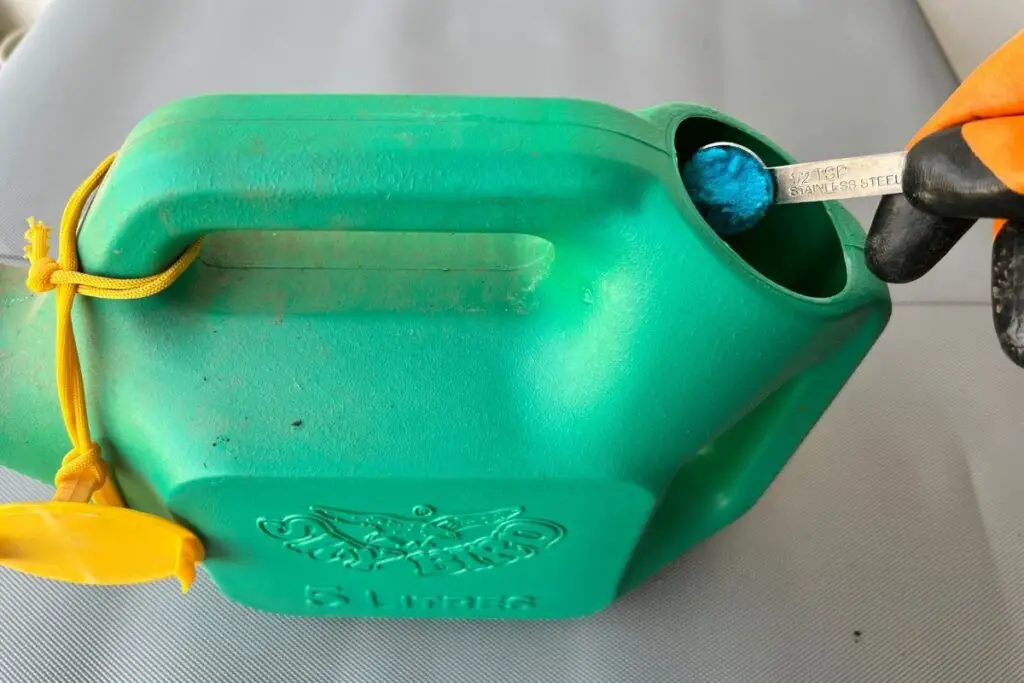
Hibiscus requires average nitrogen, low phosphorus, and high potassium.
Anything more or less will affect flowering.
High nitrogen: Nitrogen is usually used for foliage growth.
Excessive nitrogen will make the plant grow more leaves at the price of blooms.
High phosphorus: As I said earlier, Hibiscus requires low phosphorus.
Excessive phosphorus in the soil prevents the roots from absorbing other essential nutrients.
It further stops the plant from flowering.
If not fixed in time, it can even kill the plant. An initial sign is yellow leaves.
To save the plant from such unfavorable conditions, avoid fertilizers that don’t have a proper balance of fertilizer.
Moreover, excessive fertilizers can make the plant prone to pest infestations.
The sap-sucking insects like mealybugs or aphids feed on the sap of the plant, thus weakening the plant and making it drop flower buds.
Use a proper balanced liquid fertilizer once a month during growing months or use organic matters as mulch.
Also read: What Is A Good Fertilizer For Hibiscus Plants? (Ideal Ratio+Best Pick)
Looking for gardening supplies? We have tested 100's of products before recommending them to you guys. Check out our best pick below:
| Image | Gardening Supplies | Best Price? |
|---|---|---|
 Top
Top Top
Top | Raised Garden Bed Kit | Check On Amazon |
 | XLUX Soil Moisture Meter, Plant Water Monitor, Soil Hygrometer Sensor for Gardening, Farming, Indoor and Outdoor Plants, No Batteries Required | No Results |
 Top
Top Top
Top | 82 Pcs Garden Tools Set and Extra Succulent Tools Set | Check On Amazon |
 | Joeys Garden Expandable Garden Hose with 8 Function Hose Nozzle, Lightweight Anti-Kink Flexible Garden Hoses, Extra Strength Fabric with Double Latex Core, (50 FT, Black) | No Results |
 Top
Top Top
Top | Dual Chamber Compost Tumbler | Check On Amazon |
 Top
Top Top
Top | Sunnyglade Plant Stakes | Check On Amazon |
 Top
Top Top
Top | Organic Cold Pressed Neem Seed Oil | Check On Amazon |
 Top
Top Top
Top | Mighty Mint Gallon :-Insect and Pest Control Peppermint Oil | Check On Amazon |
 Top
Top Top
Top | Scotts DiseaseEx Lawn Fungicide | Check On Amazon |
 Top
Top Top
Top | Jacks Classic 20-20-20 All Purpose Fertilizer | Check On Amazon |
 Top
Top Top
Top | 30,000 Seeds Pollinator Attracting Wildflower Mixture | Check On Amazon |
 Top
Top Top
Top | Survival Vegetable Seeds Garden Kit-Over 16,000 Seeds | Check On Amazon |
Wrong pruning time
Growing month is not the right time to prune Hibiscus heavily.
It will affect the flowering.
Either the plant won’t flower, or they will flower lately during the fall.
It is also not good to prune the Hibiscus just before the cold weather arrives.
If the plant produces flowers in the cool months, they will wilt and fall off as winter approaches.
Climate problems
Hibiscus is generally native to tropical and subtropical climates where warm, humid, and sunny environments.
Two types of Hibiscus are common, Tropical and Hardy.
The Tropical Hibiscus enjoys warm and humid but cannot tolerate cold weather.
They grow best in zones 9 to 11.
The Hardy Hibiscus plants can tolerate some amount of cold and are native to zones 4-8.
Hibiscus won’t flower in the winters.
Tropical varieties will flower year-round if they receive warm temperatures the whole year and are taken indoors in winters and kept in a room with ideal warm temperatures.
The ideal temperature for flowering ranges between 60 and 80°F.
If the temperature exceeds or drops below this range, it will affect flowering.
So, if you find your Hibiscus not flowering, first know about the species you are growing and your area’s climate.
Also read: Hibiscus Temperature Tolerance: Ideal Range+USDA Zones
Low humidity levels
Belonging to tropical regions, Hibiscus enjoys high humidity, around 50% to 70%.
If they get exposed to excessively dry air, they will begin to drop the flower buds.
As a result, there won’t be any blooms.
Pests
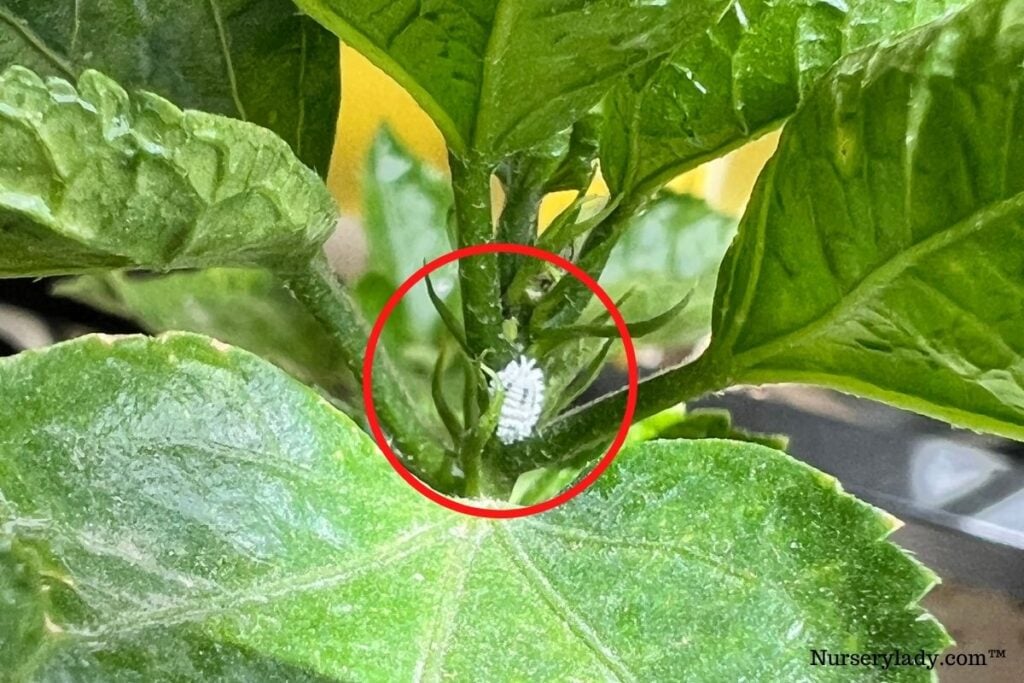
Pests like aphids, mealybugs, thrips, scales, and whiteflies feed on the plant and make it weak, due to which the plant begins to drop its flower buds.
The result is no flowering in the plants.
Aphids: These small, green, or white bugs suck the sap of the plant and the buds.
It further weakens the plant and destroys the buds before flowering.
They also secrete a sticky substance called honeydew and make the leaves sticky.
Over time, it develops sooty mold.
Mealybugs: Tiny white-bodied insects with white cottony waxy, mealybugs also feed on the plant fluids and release honeydew.
The waxy body works as a shield to protect from pesticides.
They are found under the leaves and flower buds.
Whiteflies: These are small white-winged insects that feed and live under the leaves.
They, too, are sap-suckers.
The honeydew they secrete creates mold over the leaves, which affects photosynthesis.
As a result, the plant loses its energy to produce buds or blooms.
Potted Hibiscus not blooming
Drainage: A container without drainage holes will stop the excess water from flowing out.
This keeps the roots wet and eventually rots them.
Old pot for several years: A plant staying in the same pot will not bloom.
Based on the plant size, the amount of soil in the pot is very low.
That is why the plant fails to receive enough nutrients.
Additionally, the soil will become compact, and giving water or nutrients in such soil will only lead them to flow out of the drainage holes.
Small pots hold less soil and thus dry quickly: If a Hibiscus is standing in a small pot, the amount of soil the pot is carrying is not enough for the plant.
As a result, the plant will receive less water and nutrients than they require.
Moreover, the soil will heat up quickly and cause dehydration.
This deficiency of water and nutrients affects flowering.
Rootbound: In a small pot, the plant will become rootbound.
Due to lack of space, the roots will grow in a circular motion and become compact over time.
They will even grow out of the potholes and from the soil surface.
This will minimize the amount of soil and block the drainage holes.
It also causes overwatering and invites fungal diseases, ultimately affecting blooming.
How can I make the Hibiscus bloom again?
To encourage them to bloom again, you first need to solve the problems.
For stimulating flowering, you need to prevent these problems from further re-appearance.
Give them enough sunlight
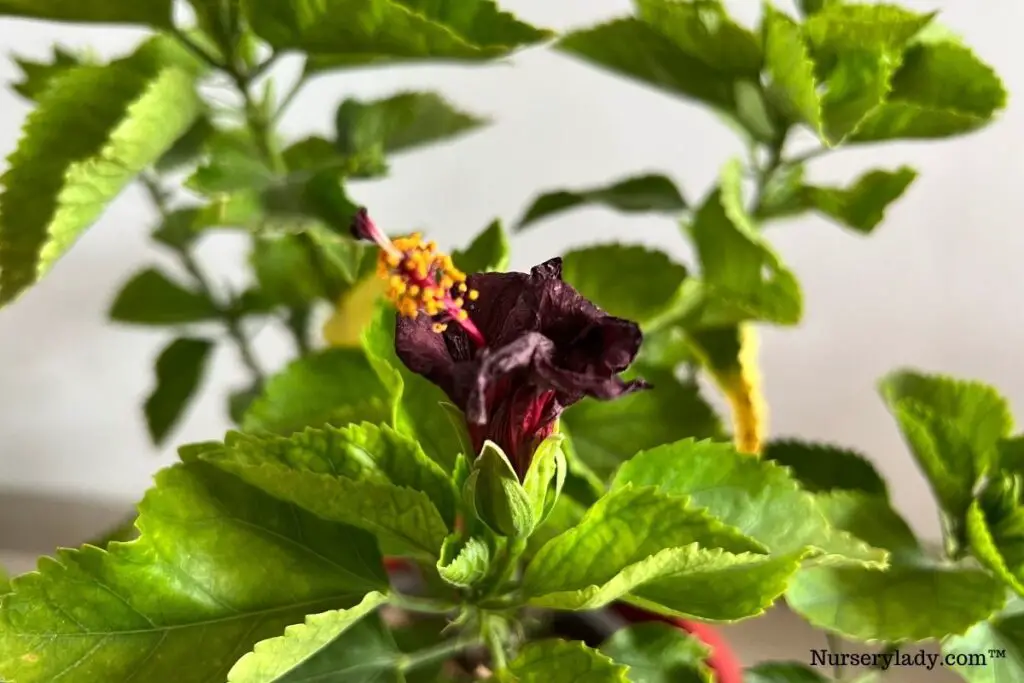
Hibiscus is a sun-loving plant.
Without enough sunlight, they will not use their energy at full potential to flower.
- If Hibiscus receives shade due to tall trees, cut some of them to let the plant have enough sunlight.
- If they are in pots, shift them to a sunny spot.
- If they are indoors, place them near a sunny spot.
- If the sunlight is too intense for the plant to handle, let them have at least 2-3 hours of direct sun and 6-8 of indirect sunlight for the rest of the day. Never deprive them of light.
- You can always put on shading nets to filter the scorching sun.
Also read: How Much Light Does A Hibiscus Plant Need? (What Kind, How Much & More)
Improve your watering habits
If you have overwatered your Hibiscus plants, stop watering and let the soil (at least 1-2 inches of the topsoil) dry before the next watering.
If you have not watered the plant for a long time, immediately give them enough water.
Within a few weeks, your plant will begin to recover.
They will not flower unless they have completely recovered.
They will flower if the weather remains ideal for blooming.
- Ensure to water the plant when the top 1-2 inches are dry.
- If you use pots and keep them in over a saucer, check the tray for any water accumulation and empty it from time to time. It will save the plant from standing over a pool of water.
- Don’t water too frequently during the winters as the soil stays moist for a long time due to low evaporation and fewer daylight hours.
- Water the Hibiscus 3 to 5 times per week.
- During the hot summers, water the plant daily, sometimes 2-3 times in one day if the weather is too scorching.
Also read: How To Water Hibiscus Plant? (How Much, How Often & More)
Correct the fertilization
When your plant shows signs of over-fertilization, stop fertilizing for some weeks and increase watering.
The plant might not flower this season, but they will flower the next season if they recover.
- Apply organic mulches to improve the quality of the soil.
- Use a fertilizer with average nitrogen, low phosphorus, and high potassium.
- Never use a fertilizer whose balance doesn’t match the plant requirement. You can use a fertilizer with an NPK value of 17-5-24, 6-4-6, or 10-4-12.
Also read: What Is A Good Fertilizer For Hibiscus Plants? (Ideal Ratio+Best Pick)
Improve the soil quality

The plant will show the signs of poor watering if the soil is poor drainage.
The soil must be well-drained and also well-retentive.
If the soil is too clayey, add sand, perlite, or gypsum to improve the drainage.
Add perlite, compost, or other organic matter if the soil is too sandy.
Perlite is generally used to improve drainage.
But, it also retains moisture to some extent.
To prevent such conditions, below are some soil mixes you can use:
- 2 parts garden soil, 1 part compost, and 1 part sand
- 1/3 each of potting soil, compost, and peat moss
- Equal parts of composted bark, composted manure, and coarse peat mixed with some vermiculite
Also read: What Kind Of Soil Does A Hibiscus Plant Like? (+Best Soil Mix)
Prune at the right time
You must prune the Hibiscus at the end of the growing season.
If you have already pruned, then the blooming will get affected.
To prevent this, prune the Hibiscus after summer, at the end of the growing months around September and October.
Then you can witness new growth the next spring.
If you want to prune in the early spring, it should be a light pruning, around 20-30%.
Potted plants
To encourage flowering in the potted plants:
- Use containers with drainage holes.
- Repot the Hibiscus every year. However, you must also check whether the plant is ready or not.
- Change the soil as it can get depleted over time.
- Use a container 1-2 inches bigger than the present one if you want it to increase a little bigger.
- Don’t use a small pot for your plant.
Also read: What Kind Of Pot Is Best For Hibiscus? (Size, Material & More)
Maintain the right humidity
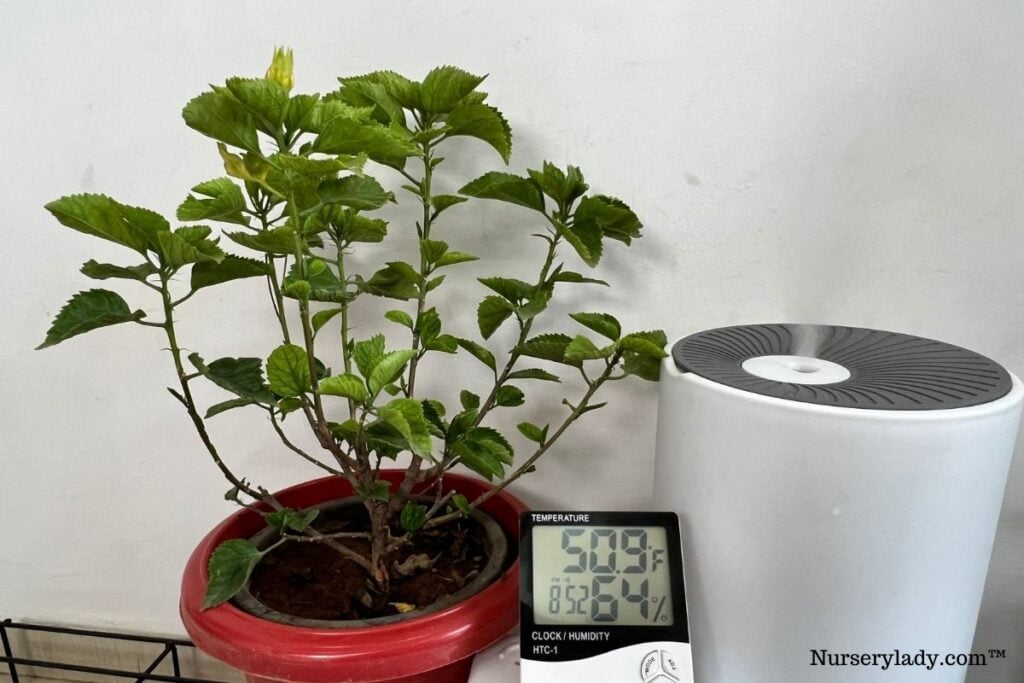
If you see that the plant is not facing any problem other than bud dropping, maybe it is due to humidity.
Consider checking the humidity around your Hibiscus with a hygrometer.
If it shows below 50%, you have to increase it.
- Mist your plants daily. Or, install a misting system around your plant.
- Keep water trays around your plant or group multiple plants.
- Check whether there are any tall trees around the Hibiscus or not.
These trees can increase humidity in two ways:
The dewdrops falling on Hibiscus can increase humidity and work like misting.
The tall trees won’t let the humidity escape from the surrounding area of Hibiscus.
Indoors, there are many ways to increase humidity like pebble trays, grouping, misting, and keeping water tanks around.
The best method is to use a humidifier.
Also read: Do Hibiscus Like To Be Misted? (+Humidity Requirements)
Check for pests
Other than bud dropping, the plant will show other signs of pest infestation, like distorted leaves, weak plants, sticky leaves, etc.
Overwatering, droughts, overfertilization, and poor nutrient soil are common reasons behind pest infestation.
You must avoid these issues to prevent the bugs from invading your plant.
Check for these signs and treat the problem as soon as possible.
To get rid of pests:
- Mist your plant with Neem oil. It will work after 2-3 applications.
- Release ladybugs, lacewings, and mantis to let them feed on the soft-bodied bugs.
- Dab or spray rubbing alcohol over the infected area. This will kill the hard-shielded bugs like the hard-bodied scales and mealybugs.
- Use yellow sticky cards to trap the flying bugs.
- Use insecticidal soaps to get rid of them.
After treatment, your plant won’t bloom immediately.
They will take the present year to recover from this infestation.
If they become healthy, they will produce flowers the following year.
Also read: How Do I Get Rid Of Bugs On My Hibiscus? (Common Bugs+Fix)
How to keep the Hibiscus blooming?
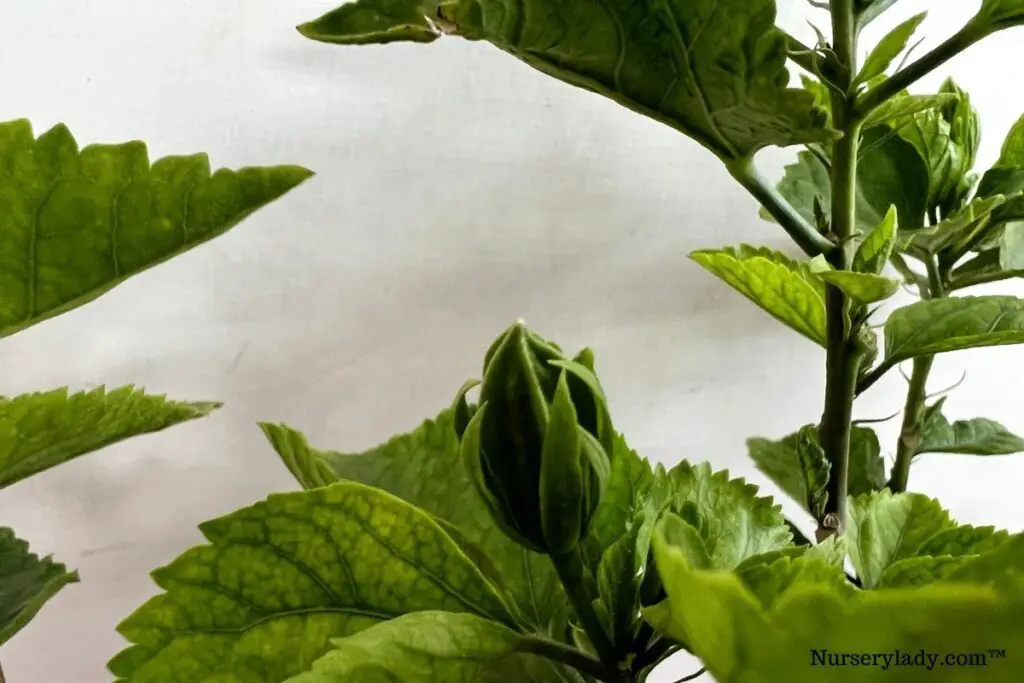
There are multiple reasons behind Hibiscus not blooming.
If you deal with the problems and prevent them from further occurrence, you can encourage your plant to continue blooming.
However, a few reasons are natural about which there is nothing to do.
So, here are some steps to make your Hibiscus bloom constantly:
- Use the right variety according to your zone. If you belong to zones 9-11, grow Tropical Hibiscus. Tropical Hibiscus will bloom the whole year if they receive warm temperatures and stay indoors in winters.
- Repot your Hibiscus every year during January or February. While repotting, prune the damaged roots.
- Prune the Hibiscus only by 1/3rd or ½ in the early spring. Heavy pruning can affect flowering. This slight pruning will help them grow and produce flowers in the growing months.
- Keep the Tropical Hibiscus outdoors in late April if they are indoors. The more sunlight they receive, the more they will bloom.
- Increase watering when the weather warms up. Water them daily in the morning. Sometimes, the plant might require watering 2 times a day, especially if the weather is scorching. Provide as needed.
- Add a layer of mulch to help the soil retain moisture.
- Fertilize the plant every 2 weeks with a water-soluble fertilizer. This will give the plant the essential nutrients immediately and promote quick flowering. Use the combination as I suggested.
- Use well-drained soil. Follow the soil mixes I shared. You can also go through the Hibiscus soil article for more soil mixes.
- Cut the tips of the stems in the spring and summer. This will encourage multiple stem growth, thus promoting more blooms.
- Before the first frost arrives, shift your plant to a shed or take them indoors. They should not get the temperature below 32°F. Water them rarely only to maintain hydration.
Final words
Taking proper care of the plant and maintaining the right care tips is the only way to make Hibiscus bloom.
Give them sufficient sunlight, practice good watering habits, use well-drained soil, fertilize from time to time with a well-balanced fertilizer, prune at the right time, maintain high humidity and protect them from pests.
Grow the right kind of variety depending on your living area.
Reference: Wikipedia, ASPCA, Louisiana State University Agricultural Center, American Society for Horticultural Science, Tropical Hibiscus by Texas A&M University, Sciencedirect.
